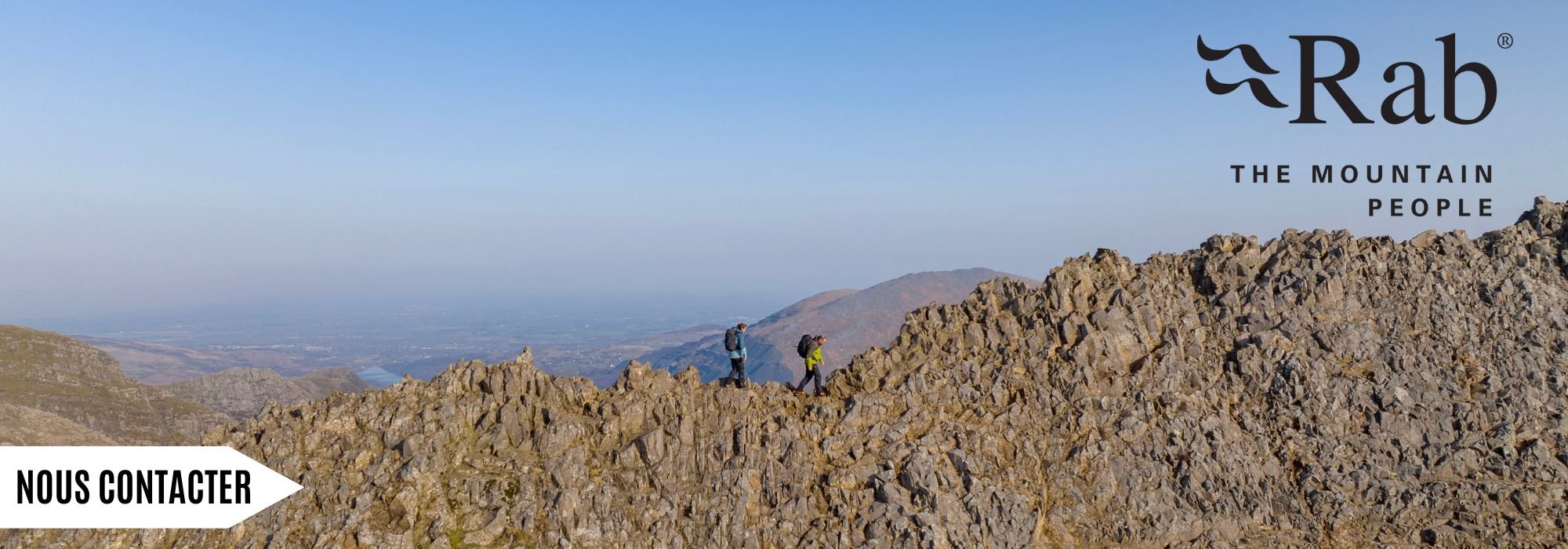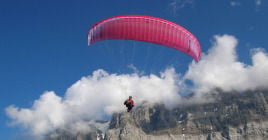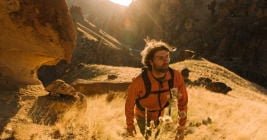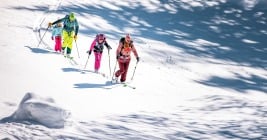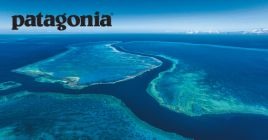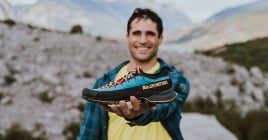In this article, we propose that you learn more about the design of your waterproof jacket, its durability and breathability to help you choose the right Rab jacket for you!
What is waterproofing a jacket?
To waterproof a fabric, you need to create a barrier that prevents water from penetrating. Most fabrics are inherently porous and allow water to penetrate and be absorbed.
Early waterproofing was done by coating fabrics with oils or waxes, but these weighed down the garment and had to be constantly reapplied. Today, modern waterproof fabrics include a thin waterproof layer that can be designed to let things like sweat through to make the garment more comfortable.
Waterproofing through coatings
The very first breathable and waterproof barrier was created by applying a coating to a piece of fabric. This remains the simplest method of waterproofing a garment today. A liquid coating is applied directly to a fabric, just as you would apply paint to a wall with a roller. The result is a flexible, durable coating.
Coatings can be made from a variety of materials, applied in layers of varying thicknesses and treated to provide a range of different characteristics. At Rab, this method is not currently used.
Waterproofing by lamination
Laminating consists of applying a thin membrane to a fabric to form several layers. The membrane is made up separately and then glued or laminated to the surface fabric.
Different materials and extrusion processes will give different characteristics to the finished piece.
Rab works closely with its partners and textile mills to select and combine fabrics and membranes to create products that are perfectly suited to the intended use.
DID YOU KNOW?
 |
These layers are extremely thin. At Rab, membranes ranging from 7 to 30 microns thick are used for lamination. For comparison, a human hair is about 100 microns thick. Thin membranes offer increased breathability, ideal for activities requiring speed and lightness, while thicker membranes provide more durable waterproofing. |
The Durable Water Repellent (DWR) treatment method
Water repellent is not the same as waterproof. DWR treatment is applied to the outside of the fabric. It causes water droplets to bead up on the surface of the fabric, which reduces the amount of standing water and prevents moisture from penetrating the outer fabric.
This in turn allows the membrane to work efficiently. The DWR treatment should be maintained regularly throughout the product's life cycle to ensure optimal performance of the garment over time.
How do I know if my jacket is waterproof?
However, a higher level of waterproofing will result in a more durable garment that will remain waterproof longer.
As more water is added, the pressure on the fabric increases. The results are expressed as the height of the water column that the fabric can withstand before water is allowed to penetrate. For example, a hydrostatic pressure (HH) of 1,500 mm (1.5 m) to 30,000 mm (30 m). In the industry, the standard for a fabric to be considered waterproof is 1,500 mm.
It is often at these points of contact that moisture can seep into the garment, when the right combination of materials and technologies has not been employed.
Design and durability of your waterproof garments
There are three different methods used to make most waterproof fabrics, whether coated or laminated. Each method gives the fabrics different characteristics and offers a different field of application.
| 2 PLYERS | 2.5 PLYERS | 3 LAYERS |
| This method is the simplest. It consists of applying a laminated or coated membrane to a single layer of fabric. This method is used by Rab for its shelters, when the membrane is not subject to any direct abrasion. Two-layer coated membranes used in clothing often require additional liners to protect them. |
With the 2.5-layer method, a light protective film or varnish is applied to the surface of the membrane to enhance durability and protection without affecting breathability. This design offers increased strength over the traditional 2-layer design. It also offers more softness and better value than a more complex 3-layer design. | The 3-layer design sandwiches the membrane between an outer fabric and an extremely lightweight woven or knitted inner fabric. The 3-layers offer increased strength, protection and comfort, but are the most complex to manufacture. The 3-layer design is the most widely used technology in Rab outerwear because it allows for a range of fabrics, from the strongest and most durable to the lightest and most compact. |
Some waterproof fabrics are stronger simply because of the manufacturing method used. However, there are other factors that affect the durability of the garment, including other materials and fabrics (such as nylon or polyester), membranes (PU, PE, ePTFE...), the number of deniers and weight of the face fabric, and the method of construction, i.e. woven or knitted.
In addition to the exhaustive strength tests performed by the fabric manufacturers, Rab tests all of its designs in their own laboratory and sends them to specialized testers and athletes who test them in the field.

The different technologies at Rab
GORE-TEX®
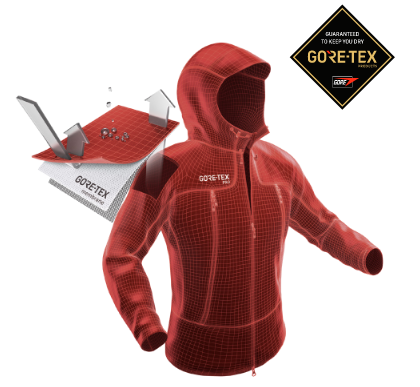 |
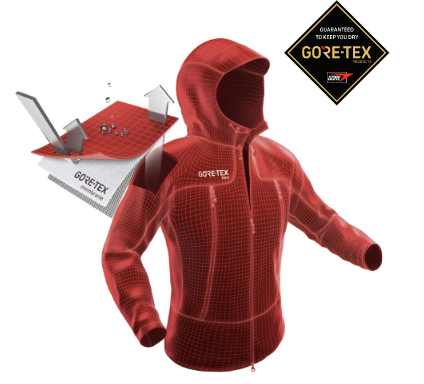 |
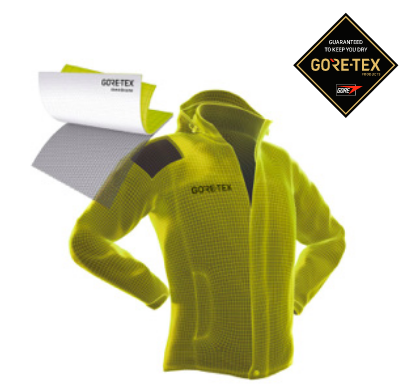 |
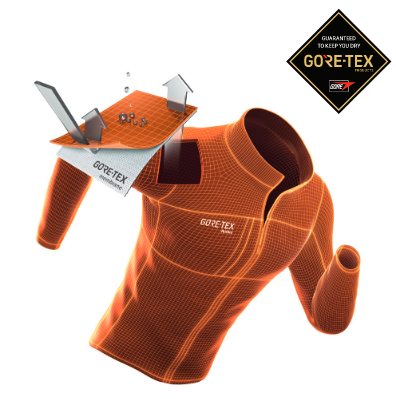 |
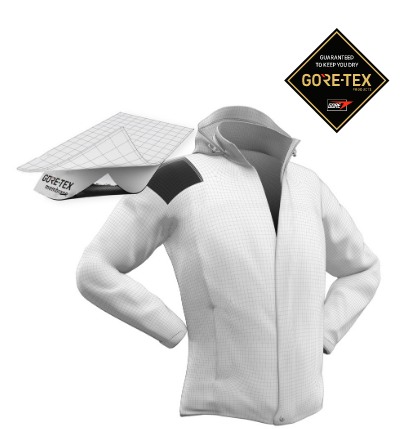 |
| GORE-TEX® PRO MOST RUGGED TECHNOLOGY™ |
GORE-TEX® PRO MOST BREATHABLE TECHNOLOGY™ | GORE® C-KNIT BACKER TECHNOLOGY | GORE-TEX® ACTIVE | GORE-TEX® PACLITE PLUS |
| This two-component membrane is the ideal choice when abrasion resistance and durability of a garment subjected to demanding and prolonged use are key concerns. The Gore ePTFE membrane is combined with a PU (polyurethane) element and tough surface fabrics for added durability. Using this membrane in areas prone to heavy wear or contamination by sebum and dust strengthens the product without compromising its breathability. |
As the name implies, this is the most breathable Pro membrane. The pores of this ePTFE membrane not only allow for water vapor exchange, but also air exchange, ensuring a constant flow of air and moisture from the inside to the outside of the garment. This increased airflow is essential to your comfort. We use GORE-TEX® Pro Most Breathable Technology™ in combination with GORE-TEX® Pro Most Rugged Technology™ to achieve exceptional durability and breathability, or alone to create the most breathable Gore Pro products in the Rab line. |
GORE® C-KNIT™ Backer Technology features an extremely thin circular knit that forms the thin inner layer of the three-layer laminate. Soft and supple to the touch, this thin inner fabric is extremely comfortable worn next to the skin or over other layers. It is very smooth, allowing it to slide over the layers worn underneath for added comfort. |
When exceptional breathability, compactness, and lightness are a must, the GORE-TEX® Active membrane delivers. Coupled with thin, lightweight face fabrics, this dual material combining ePTFE and PU membranes is thinner than the average Gore membrane. Still, it offers durable waterproofing perfect for activities that require speed and lightness, like trail running or mountain biking. |
Designed for the unexpected, GORE-TEX® Paclite Plus is the ultimate back-up solution: it's lightweight, so you can carry it with you at all times, and it provides durable waterproofing when needed. A new surface treatment applied to the inside of this two-layer fabric ensures greater durability while making the fabric more comfortable to wear during all your activities. This surface treatment does not add weight to the garment and provides a more pleasant feel than previous versions. |
| Latok Mountain Rab Jacket | Khroma Rab Jacket | Ladakh Rab Jacket | Zenith Rab Jacket | Meridian Rab Jacket |
PROFLEX™
The PU membrane is naturally stretchy and works in symbiosis with the knitted or woven fabrics to maintain this stretch and provide a lightweight, soft, waterproof three-layer fabric. The inner fabrics of the Proflex™ laminates have excellent wicking properties that work in concert with the hydrophilic membrane to speed up the process of moisture wicking, from your body to the outside. The surface fabric has a DWR treatment that allows the membrane to perform optimally over time.
PERTEX® SHIELD
Durable, waterproof and highly breathable, Pertex® Shield fabrics offer lightweight, versatile protection from the elements. Rab uses a wide variety of fabrics combined with membranes from the Pertex® Shield range with different characteristics, including microporous, hydrophilic, breathable and fully recycled membranes.
Discover waterproof jackets for men and women
What questions should you ask yourself when choosing a protective jacket?
To find the right jacket for you, it is important to ask yourself these questions:
How many layers will you wear underneath? What type of environment will you be working in?
Rab's textile designers and engineers are always thinking about the different layers you might need under our outerwear. you might need under our outerwear. Outerwear designed for cold climates are cut so that an insulating layer has enough room to expand underneath, while a fast, lightweight garment will be cut closer to the body to reduce the amount of fabric the amount of fabric used, and therefore the weight.
What will be the primary use of the outerwear?
While many of the Rab products can be worn for a variety of activities, each is designed for a specific purpose. If you spend 80% of your time running in the mountains, or if you're a guide spending your winters in the Scottish Highlands, an outerwear garment specifically designed for your activity will be useful. A heavy-duty three-layer waterproof jacket with reinforcements designed for winter mountaineering will not be the best choice if you also want to use it for trail running. So be sure to choose your garment based on its primary use, or find a compromise.
What balance do you want between weight, waterproofing, durability and breathability?
When shopping for a jacket, it's important to consider the trade-off between weight, waterproofing, durability and durability and breathability. If you want to travel quickly and lightly, or if you want a waterproof jacket only to be used for sporadic showers in warm weather, it may be worthwhile to invest in a lighter garment that will take up less space in your bag and be more comfortable to wear. comfortable to wear. However, if you're used to really roughing up your gear, it's worth to invest in a product with a stronger surface fabric that can withstand repeated abuse. repeated abuse. These garments are often less breathable, but they remain waterproof longer than their lighter than their lighter counterparts.
What features are required for my chosen activity or use?
Rab products have a set of features designed for the intended use. Mountaineering outerwear has multiple storage pockets for essentials, zippers with heavy-duty sliders that can be pulled with gloves, and hoods that are helmet compatible. Conversely, outerwear designed for mountain running is streamlined for maximum weight reduction, can usually be slipped into a storage bag, and has lighter zippers and features.
If you want a product with multiple storage options or that can be used with gloves, you'll probably end up with a product with mountaineering features. However, if weight is the key factor in your decision-making process, be prepared to compromise and sacrifice some features.
TO REMEMBER:
- RAB HAS A RANGE OF WATERPROOF JACKETS FOR ALL OUTDOOR ACTIVITIES WITH DIFFERENT DESIGNS, TECHNOLOGIES AND FEATURES.
- TO KNOW IF YOUR PRODUCT IS WATERPROOF, REFER TO THE WATER COLUMN MEASUREMENT.
- ASK YOURSELF THE RIGHT QUESTIONS AND CHOOSE THE RIGHT JACKET FOR YOUR ACTIVITY.
